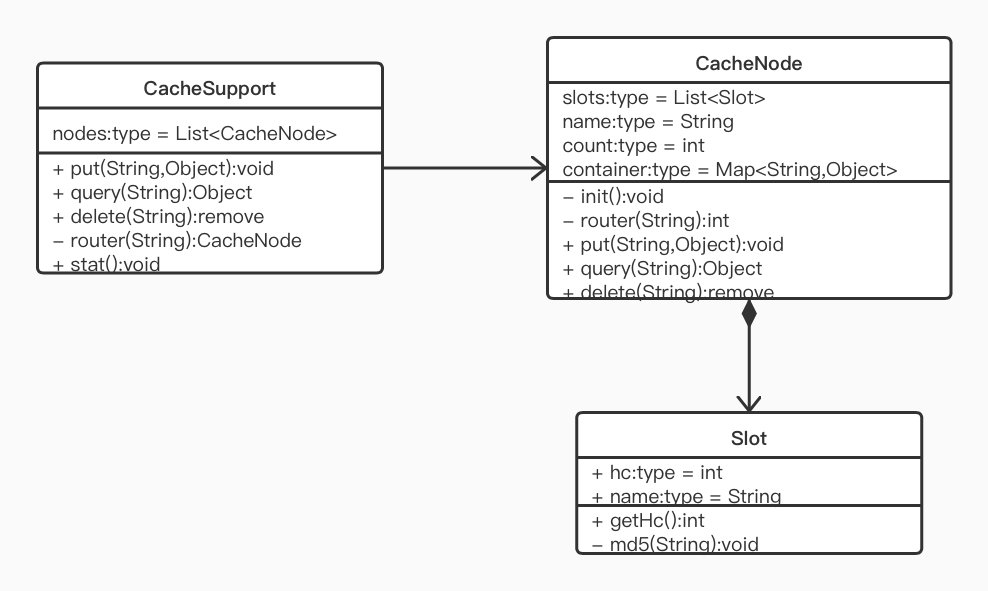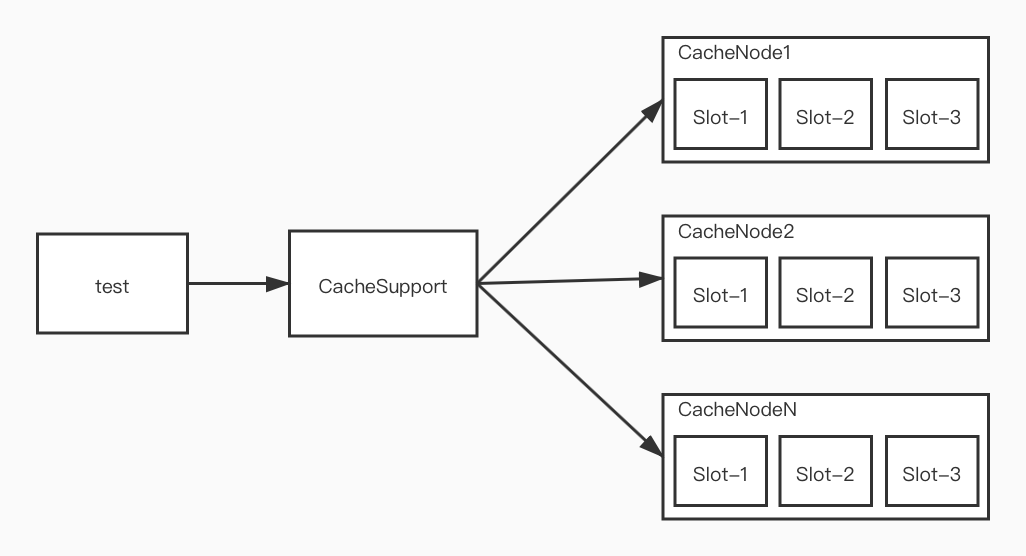架构师 3 期 3 班 -week5- 作业
发布于: 2020 年 12 月 22 日
作业题目
用你熟悉的编程语言实现一致性 hash 算法。
编写测试用例测试这个算法,测试 100 万 KV 数据,10 个服务器节点的情况下,计算这些 KV 数据在服务器上分布数量的标准差,以评估算法的存储负载不均衡性。
解答
类图

部署图

代码实现
Slot 类是虚拟结点类,负责散落在hash环上给实际的CacheNode结点“占坑”。
这里给结点的名字先做了md5 再取hash值,为了让结点散落更平均,避免a-1,a-2,a-3这样的hash值太接近。
import java.io.UnsupportedEncodingException;import java.security.MessageDigest;import java.security.NoSuchAlgorithmException;public class Slot { private int hc;//hashcode private String name;//slot的name public Slot(String node, int id) { this.name = node + "-" + id; //避免散列不均衡 this.hc = md5(this.name).hashCode(); } public int getHc() { return hc; } public boolean equals(Object o) { if (this == o) return true; if (o == null || getClass() != o.getClass()) return false; Slot slot = (Slot) o; return hc == slot.hc; } public int hashCode() { return hc; } private String md5(String txt) { try { byte[] b = MessageDigest.getInstance("md5").digest(txt.getBytes("UTF8")); StringBuffer stringBuffer = new StringBuffer(); for (int i = 0; i < b.length; i++) { stringBuffer.append(Integer.toHexString((0x000000FF & b[i]) | 0xFFFFFF00).substring(6)); } return stringBuffer.toString(); }catch (NoSuchAlgorithmException | UnsupportedEncodingException e){ return null; } }}
CacheNode类是实质的存储结点,提供存储的容器和计算传入的key应该落在哪个Slot上。
这里将Slot集合按hash值升序排列,在选择key的落点时,可以减少一部分循环。
import java.util.*;public class CacheNode { private String name;//结点名称 private int count;//虚拟结点数 private List<Slot> slots;//虚拟结点集合 private Map<String,Object> container;//实际的存储容器 public CacheNode(String name, int count) { this.name = name; this.count = count; this.slots = new ArrayList<>(count); this.container = new HashMap<>(); init(); } private void init(){ for (int i = 0; i < count; i++) { Slot slot = new Slot(name,i); if (!slots.contains(slot)){ slots.add(slot); } } //排序为了优化轮训 slots.sort((o1, o2) -> Integer.compare(o1.getHc(), o2.getHc())); } public int router(String key){ for (Slot slot : slots){ if (key.hashCode() <= slot.getHc()) return slot.getHc(); } return slots.stream().findFirst().get().getHc(); } public void put(String key,Object value){ container.put(key,value); } public Object query(String key){ return container.get(key); } public void remove(String key){ container.remove(key); } public int getContainerSize(){ return container.size(); } public String toString() { return "CacheNode{" + "name='" + name + '\'' + ", slot count=" + count + ", size =" + container.size() + '}'; }}
CacheSupport类是一个提供集群支持的类,提供扩容的add方法、路由方法和集群的状态信息打印。
import java.math.BigDecimal;import java.util.*;public class CacheSupport { private List<CacheNode> nodes; public CacheSupport() { this.nodes = new ArrayList<>(); } public void addNode(CacheNode node){ this.nodes.add(node); } public void put(String key,Object value){ CacheNode cacheNode = router(key); cacheNode.put(key,value); } public Object query(String key){ CacheNode cacheNode = router(key); return cacheNode.query(key); } public void remove(String key){ CacheNode cacheNode = router(key); cacheNode.remove(key); } private CacheNode router(String key){ Map<Integer,CacheNode> result = new HashMap<>(nodes.size()); ArrayList<Integer> sort = new ArrayList<>(); for (CacheNode node : nodes){ int hc = node.router(key); if (!result.containsKey(hc)) { result.put(hc,node); sort.add(hc); } } if (sort.size() > 0){ sort.sort((o1, o2) -> Integer.compare(o1, o2)); return result.get(sort.stream().findFirst().get()); } throw new RuntimeException("node not found"); } public void stat(){ ArrayList<Integer> integers = new ArrayList<>(); for (CacheNode node : nodes){ System.out.println(node.toString()); integers.add(node.getContainerSize()); } System.out.println("总体标准差:"+cal(integers)); } //计算总体标准差:PSD= sqrt(1/(N)*((x1-xm)^2+(x2-xm)^2+..+(xN-xm)^2)) private double cal(ArrayList<Integer> integers){ Integer total = integers.stream().collect(Collectors.summingInt(x->x)); double avg = new BigDecimal(total).divide(new BigDecimal(integers.size()) ,2,BigDecimal.ROUND_HALF_UP).doubleValue(); double total_σ2 = 0; for (int n : integers){ total_σ2 += Math.pow(Math.abs(n - avg),2); } double avg_σ2 = new BigDecimal(total_σ2).divide(new BigDecimal(integers.size()) ,2,BigDecimal.ROUND_HALF_UP).doubleValue(); return Math.sqrt(avg_σ2); }}
测试类
测试类测试,计算平均差
import java.util.UUID;public class Test { public static void main(String[] args) { CacheSupport support = init(); for (int i = 0; i < 1000000; i++) { String key = UUID.randomUUID().toString().replaceAll("-",""); support.put(key,i); } support.stat(); } public static CacheSupport init(){ String[] names = {"a","b","c","d","e","f","g","h","i","j"}; int Node_Slot_Count = 150; CacheSupport support = new CacheSupport(); for (int i = 0; i < 10; i++) { support.addNode(new CacheNode(names[i],Node_Slot_Count)); } return support; }}
输出如下:
CacheNode{name='a', slot count=150, size =111435}CacheNode{name='a', slot count=150, size =111854}CacheNode{name='b', slot count=150, size =96863}CacheNode{name='c', slot count=150, size =101839}CacheNode{name='d', slot count=150, size =117949}CacheNode{name='e', slot count=150, size =89642}CacheNode{name='f', slot count=150, size =92350}CacheNode{name='g', slot count=150, size =108235}CacheNode{name='h', slot count=150, size =93825}CacheNode{name='i', slot count=150, size =100214}CacheNode{name='j', slot count=150, size =87229}平均差:9543.622781732312
这里我用了 50,100,150,300,600,1000,2000,4000,8000几个虚拟结点数做测试
测试下来,
虚拟结点数相同,标准差相对稳定
大的趋势是结点数越多,标准差越小。
虚拟结点数量大到一定程度,标准差变化就很小了,而计算key落地点的轮询时间明显变长。
所以选择150 应该是在时间和存储均衡之间的权衡
划线
评论
复制
发布于: 2020 年 12 月 22 日阅读数: 14
版权声明: 本文为 InfoQ 作者【zbest】的原创文章。
原文链接:【http://xie.infoq.cn/article/76328e4b7f68b70747c639591】。未经作者许可,禁止转载。
zbest
关注
一个胖子 2020.11.04 加入
一个不正经的java程序员, 整天写着openresty和go的代码, 努力从键摄向非职业摄影师迈进, 快要溺死在内耗里的中年人, 胖子。












评论